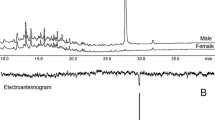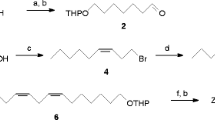Abstract
Phthia picta is part of a complex of true bugs (Heteroptera) in Brazil that attack tomatoes, being particularly damaging because nymphs and adults feed on both leaves and fruit. Gas chromatography (GC) of aeration extracts of adult males vs. females revealed the presence of a male-specific compound. GC-electroantennographic detector experiments indicated that the antennae of females are highly sensitive to this male-specific compound. GC-mass spectrometry and GC-FTIR analyses suggested a methyl branched hydrocarbon structure for this compound. After synthesis of three different proposed structures, the natural product was indentified as 5,9,17-trimethylhenicosane, which was strongly attractive to females in Y-tube olfactometer bioassays. Analysis of dissected body parts of adults revealed that the pheromone is produced in the lateral accessory glands of the metathoracic scent gland of males only.









Similar content being viewed by others
References
Aldrich, J. R. 1988. Chemical ecology of the Heteroptera. Annu. Rev. Entomol. 33:211–238.
Aldrich, J. R., Blum, M. S., Hefetz, A., Fales, H. M., Lloyd, H. A., and Roller, P. 1978. Proteins in a non-venomous defensive secretion - biosynthetic significance. Science 201:452–454.
Aldrich, J. R., Kochansky, J. P., Lusby, W. R., and Dutky, S. R. 1982. Volatile male-specific natural-products of a Coreid bug (HEMIPTERA, HETEROPTERA. J. Chem. Ecol. 8:1369–1376.
Aldrich, J. R., Waite, G. K., Moore, C., Payne, J. A., Lusby, W. R., and Kochansky, J. P. 1993. Male-specific volatiles from nearctic and australasian true bugs (HETEROPTERA, COREIDAE and ALYDIDAE). J. Chem. Ecol. 19:2767–2781.
Aldrich, J. R., Leal, W. S., Nishida, R., Khrimian, A. P., Lee, C.-J., and Sakurantani, Y. 1997. Semiochemistry of aposematic seed bugs. Entomol. Exp. Appl. 84:127–135.
Aldrich, J. R., Oliver, J. E., Taghizadeh, T., Ferreira, J. T. B., and Liewehr, D. 1999. Pheromones and colonization: Reassessment of the milkweed bug migration model (Heteroptera: Lygaeidae: Lygaeinae). Chemoecology 9:63–71.
Aldrich, J. R., Zhang, A., and Oliver, J. E. 2000. Attractant pheromone and allomone from the metathoracic scent gland of a broad-headed bug (Hemiptera: Alydidae). Can. Entomol. 132:915–923.
Boyer, F. D., Malosse, C., Zagatti, P., and Einhorn, J. 1997. Identification and synthesis of vesperal, the female sex pheromone of the longhorn beetle Vesperus xatarti. Bull. Soc. Chim. Fr. 134:757–764.
Cortés, A. M. P., Zarbin, P. H. G., Takiya, D. M., Bento, J. M. S., Guidolin, A. S., and Consoli, F. L. 2010. Geographic variation of sex pheromone and mithocondrial DNA in Diatraea saccharalis (Fab., 1794) (Lepidoptera: Crambidae). J. Insect Physiol 56:1624–1630.
Durak, D. 2008. Morphology and chemical composition of metathoracic scent glands in Dolycoris baccarum (Linnaeus, 1758) (Heteroptera: Pentatomidae). Acta Zool. Stockholm 89:193–199.
Durak, D. and Kalender, Y. 2007. Morphology and chemical analysis of the metathoracic scent glands of Coreus marginatus (Linnaeus, 1758) (HETEROPTERA: COREIDAE) from Turkey. Entomol. News 118:227–234.
Favaro, C. F., Rodrigues, M., Aldrich, J. R., and Zarbin, P. H. G. 2011. Identification of Semiochemicals in Adults and Nymphs of the Stink Bug Pallantia macunaima Grazia (HEMIPTERA: Pentatomidae). J. Brazil. Chem. Soc. 22:58–64.
Ferreira, J. T. B. and Zarbin, P. H. G. 1996. Pheromone syntheses: A tropical approach. Enantioselective synthesis of the (2R,6S,10S) and (2S,6S,10S) isomers of methyl 2,6,10-trimethyldodecanoate. Bioorgan. Med. Chem. 4:381–388.
Fonseca, M. G., Vidal, D. M., and Zarbin, P. H. G. 2010. Male-produced sex pheromone of the cerambycid beetle Hedypathes betulinus: Chemical identification and biological activity. J. Chem. Ecol. 36:1132–1139.
Gunawardena, N. E. and Bandumathie, M. K. 1993. Defensive secretion of rice bug, Leptocorisa-oratorius fabricius, (HEMIPTERA, Coreidae) - a unique chemical-combination and its toxic, repellent, and alarm properties. J. Chem. Ecol. 19:851–861.
Kim, D.-S., Bolla, K., Lee, S., and Ham, J. 2011. One-pot preparation of hydroxylated potassium organotrifluoroborates and subsequent Jones oxidation to potassium organocarbonyltrifluoroborates. Tetrahedron 67:1062–1070.
Kovats, E. S. 1965. Gas-chromatographic characterization of organic-substances in the retention index system. Adv. Chromatogr. 1:229–247.
Leal, W. S., Panizzi, A. R., and Niva, C. C. 1994. Alarm pheromone system of leaf-footed bug Leptoglossus-zonatus (HETEROPTERA, Coreidae). J. Chem. Ecol. 20:1209–1216.
Mori, K. and Murata, N. 1994. Synthesis of methyl 2,6,10-trimethyltridecanoate, the male-produced pheromone of the stink bugs, Euschistus heros and E. obscurus, as a stereoisomeric mixture. Liebigs Ann. Chem 1994:637–639.
Biernacki W., and Gdula A. 1979. Modification of the method of Julia for the preparation of homoallylic bromides and iodides. Synthesis-Stuttgart:37–38.
Olah G.A., Prakash G.K.S., Arvanaghi M. 1984. Synthetic methods and reactions .109. Improved preparation of aldehydes and ketones from n,n-dimethylamides and Grignard-reagents. Synthesis-Stuttgart:228–230.
Weirauch C., and Schuh R. T. 2011. Systematics and Evolution of Heteroptera: 25 Years of Progress. pp. 487–510.
Serantes, H. E. 1973. Biologia de Phthia picta (Drury) (HEMIPTERA, Coreidae). Fitotecnica Latinoamericana 9:3–9.
Silva, R. A. D. and Carvalho, G. S. 2001. Aspectos biológicos de Phthia picta (Drury, 1770) (HEMIPTERA: Coreidae) em tomateiro sob condições controladas. Ciência Rural 31:381–386.
Silva, R. A. D., Flores, P. S., and Carvalho, G. S. 2001. Descrição dos estágios imaturos de Phthia picta (Drury) (HEMIPTERA: Coreidae). Neotropical Entomol. 30:253–258.
Silverstein, R. M., Webster, F. X., and Kiemle, D. J. 2005. pp. 502, Spectrometric Identifiction of Organic Compounds. John Wiley & Sons, Inc, New York.
Staddon, B. W. 1979. The scent glands of HETEROPTERA. Adv. Insect Physiol. 14:351–418.
Staddon, B. W. 1986. Biology of scent glands in the HEMIPTERA-HETEROPTERA. An..Soc. Entomol. Fr. 22:183–190.
Tian, X., Xie, Q., Li, M., Gao, C., Cui, Y., Xi, L., and Bu, W. 2011. Phylogeny of pentatomomorphan bugs (Hemiptera-Heteroptera: Pentatomomorpha) based on six Hox gene fragments. Zootaxa 2888:57–68.
Utermoehlen, C. M., Singh, M., and Lehr, R. E. 1987. Fjord region 3,4-diol 1,2-epoxides and other derivatives in the 1,2,3,4- and 5,6,7,8-benzo rings of the carcinogen benzo[g]chrysene. J. Org. Chem. 52:5574–5582.
Xiao, K.-J., Luo, J.-M., Ye, K.-Y., Wang, Y., and Huang, P.-Q. 2010. Direct, one-pot sequential reductive alkylation of lactams/amides with grignard and organolithium reagents through lactam/amide activation. Angew. Chem. Int. Ed 49:3037–3040.
Zarbin, P. H. G., Cruz, W. D., and Ferreira, J. T. B. 1998. Stereospecific synthesis of two isomers of (4,8)-dimethyldecanal: the aggregation pheromone of Tribolium spp. J. Braz. Chem. Soc. 9:511–513.
Zarbin, P. H. G., Ferreira, J. T. B., and Leal, W. S. 1999. Metodologias gerais empregadas no isolamento e identificação estrutural de feromônios de insetos. Química Nova 22:263–268.
Zarbin, P. H. G., Reckziegel, A., Plass, E., Borges, M., and Francke, W. 2000. Synthesis and biological activity of methyl 2,6,10-trimethyldodecanoate and methyl 2,6, 10-trimethyltridecanoate: Male produced sexual pheromones of stink bugs Euschistus heros and Piezodorus guildinii. J. Chem. Ecol. 26:2737–2746.
Zarbin, P. H. G., Arrigoni, E. D., Reckziegel, A., Moreira, J. A., Baraldi, P. T., and Vieira, P. C. 2003a. Identification of male-specific chiral compound from the sugarcane weevil Sphenophorus levis. J. Chem. Ecol. 29:377–386.
Zarbin, P. H. G., Oliveira, A. R. M., and Delay, C. E. 2003b. Diastereoselective route to (2R, 5S)- and (2S, 5S)-2-methyl-1,6-dioxaspiro[4.5]decane, a pheromone component of the wasp Paravespula vulgaris. Tetrahedron Lett 44:6849–6851.
Zarbin, P. H. G., Lorini, L. M., Ambrogi, B. G., Vidal, D. M., and Lima, E. R. 2007. Sex pheromone of Lonomia obliqua: Daily rhythm of production, identification and synthesis. J. Chem. Ecol. 33:555–565.
Acknowledgments
We thank the Empresa Paranaense de Assistência Técnica Extensão Rural, EMATER – Uraí, PR, Brazil. Coordenação de Aperfeiçoamento de Pessoal de Nível Superior (CAPES - Brazil) and Instituto Nacional de Ciências e Tecnologia de Semioquímicos na Agricultura for supporting our research. PHGZ thanks Prof. Dr. Jocelyn G. Millar (UC-Riverside) for discussions on the mass spectra. We are also grateful to Conselho Nacional de Desenvolvimento Científico e Tecnológico (CNPq) for funding the visit of Dr. Jeffrey R. Aldrich to the Federal University of Paraná (visiting researcher; proc.: 401604/2009-8).
Author information
Authors and Affiliations
Corresponding author
Rights and permissions
About this article
Cite this article
Soldi, R.A., Rodrigues, M.A.C.M., Aldrich, J.R. et al. The Male-produced Sex Pheromone of the True Bug, Phthia picta, is an Unusual Hydrocarbon. J Chem Ecol 38, 814–824 (2012). https://doi.org/10.1007/s10886-012-0147-1
Received:
Revised:
Accepted:
Published:
Issue Date:
DOI: https://doi.org/10.1007/s10886-012-0147-1




